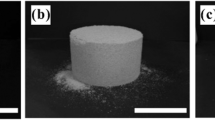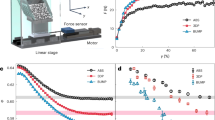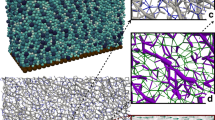Abstract
When a granular material such as sand is mixed with a certain amount of liquid, the surface tension of the latter bestows considerable stiffness to the material, which enables, for example, sand castles to be sculpted1,2,3,4. The geometry of the liquid interface within the granular pile is of extraordinary complexity and strongly varies with the liquid content5,6,7. Surprisingly, the mechanical properties of the pile are largely independent of the amount of liquid2,8,9,10,11,12,13 over a wide range14,15,16. We resolve this puzzle with the help of X-ray microtomography, showing that the remarkable insensitivity of the mechanical properties to the liquid content is due to the particular organization of the liquid in the pile into open structures. For spherical grains, a simple geometric rule is established, which relates the macroscopic properties to the internal liquid morphologies. We present evidence that this concept is also valid for systems with non-spherical grains. Hence, our results provide new insight towards understanding the complex physics of a large variety of wet granular systems including land slides, as well as mixing and agglomeration problems.
This is a preview of subscription content, access via your institution
Access options
Subscribe to this journal
Receive 12 print issues and online access
$259.00 per year
only $21.58 per issue
Buy this article
- Purchase on Springer Link
- Instant access to full article PDF
Prices may be subject to local taxes which are calculated during checkout




Similar content being viewed by others
References
Hornbaker, D. J., Albert, R., Albert, I., Barabási, A.-L. & Schiffer, P. What keeps sandcastles standing? Nature 387, 765 (1997).
Nowak, S., Samadani, A. & Kudrolli, A. Maximum angle of stability of a wet granular pile. Nature Phys. 1, 50–52 (2005).
Schiffer, P. A. Bridge to sandpile stability. Nature Phys. 1, 21–22 (2005).
Lu, N., Wu, B. & Tan, C. P. Tensile strength characteristics of unsaturated sands. J. Geotech. Geoenviron. Eng. 133, 144–154 (2007).
Iveson, S. M., Litster, J. D., Hapgood, K. & Ennis, B. J. Nucleation, growth and breakage phenomena in agitated wet granulation processes: A review. Powder Tech. 117, 3–39 (2001).
Herminghaus, S. Dynamics of wet granular matter. Adv. Phys. 54, 221–261 (2005).
Mitarai, N. & Nori, F. Wet granular materials. Adv. Phys. 55, 1–45 (2006).
Rumpf, H. Agglomeration (AIME, Interscience, New York, 1962).
Gröger, T., Tüzün, U. & Heyes, D. M. Modelling and measuring of cohesion in wet granular materials. Powder Tech. 133, 203–215 (2003).
Richefeu, V., El Youssoufi, M. S. & Radjaï, F. Shear strength properties of wet granular materials. Phys. Rev. E 73, 051304 (2006).
Soulié, F., El Youssoufi, M. S., Cherblanc, F. & Saix, C. Capillary cohesion and mechanical strength of polydisperse granular materials. Eur. Phys. J. E 21, 349–357 (2006).
Bocquet, L., Charlaix, É. & Restagno, F. Physics of humid granular media. C. R. Physique 3, 207–215 (2002).
Pierrat, P. & Caram, H. S. Tensile strength of wet granular materials. Powder Tech. 91, 83–93 (1997).
Fournier, Z. et al. Mechanical properties of wet granular materials. J. Phys. Condens. Matter 17, S477–S502 (2005).
Scheel, M., Geromichalos, D. & Herminghaus, S. Wet granular matter under vertical agitation. J. Phys. Condens. Matter 16, S4213–S4218 (2004).
Kohonen, M. M., Geromichalos, D., Scheel, M., Schier, C. & Herminghaus, S. On capillary bridges in wet granular materials. Physica A 339, 7–15 (2004).
Tegzes, P., Vicsek, T. & Schiffer, P. Avalanche dynamics in wet granular material. Phys. Rev. Lett. 89, 094301 (2002).
Samadani, A. & Kudrolli, A. Angle of repose and segregation in cohesive granular matter. Phys. Rev. Lett. 64, 051301 (2001).
Halsey, T. C. & Levine, A. J. Critical angle of wet sandpile. Phys. Rev. Lett. 80, 3141–3144 (1998).
Seemann, R., Mönch, W. & Herminghaus, S. Liquid flow in wetting layers on rough substrates. Europhys. Lett. 55, 698–704 (2001).
Brakke, K. The surface evolver and the stability of liquid surfaces. Phil. Trans. R. Soc. A 354, 2143–2157 (1996).
Geromichalos, D. et al. in Contact Angle, Wettability and Adhesion Vol. 3 (ed. Mittal, K. L.) (Diversified Enterprises, Claremont, 2003).
Geromichalos, D., Mugele, F. & Herminghaus, S. Nonlocal dynamics of spontaneous imbibition fronts. Phys. Rev. Lett. 89, 104503 (2002).
Willett, C. D., Adams, M. J., Johnson, S. A. & Seville, J. P. K. Capillary bridges between two spherical bodies. Langmuir 16, 9396–9405 (2000).
Fisher, R. A. On the capillary forces in an ideal soil; correction of formulae given by W. B. Haines. J. Agric. Sci. 16, 492–505 (1926).
Donev, A. et al. Improving the density of jammed disordered packings using ellipsoids. Science 303, 990–993 (2004).
Di Michiel, M. et al. Fast microtomography using high energy synchrotron radiation. Rev. Sci. Instr. 76, 043702 (2005).
Averdunk, H. & Sheppard, A. The Mango 3D image analysis toolkit. http://xct.anu.edu.au/mango (2007).
Frangakis, A. S. & Hegerl, R. Noise reduction in electron tomographic reconstructions using nonlinear anisotropic diffusion. J. Struct. Biol. 135, 239–250 (2001).
Sheppard, A. P., Sok, R. M. & Averdunk, H. Techniques for image enhancement and segmentation of tomographic images of porous materials. Physica A 339, 145–151 (2004).
Sethian, J. A. Level Set Methods and Fast Marching Methods: Evolving Interfaces in Computational Geometry, Fluid Mechanics, Computer Vision and Materials Science (Cambridge Univ. Press, Cambridge, 1999).
Acknowledgements
The authors thank K. Mecke and K. Jacobs for valuable discussions. Support from the European Synchrotron Radiation Facility is gratefully acknowledged. We appreciate financial support from the DFG under grant Me1361/9 and within the SFB 755. The authors are indebted to Z. Khan and F. v. Bussel for critical reading of the manuscript.
Author information
Authors and Affiliations
Contributions
Experiments were carried out by M.S., R.S., M.DM. and S.H.; theory is by M.B. and S.H.; data analysis was done by M.S., R.S. and M.B.; numerical algorithms and implementation are by A.S. and B.B.
Corresponding author
Supplementary information
Rights and permissions
About this article
Cite this article
Scheel, M., Seemann, R., Brinkmann, M. et al. Morphological clues to wet granular pile stability. Nature Mater 7, 189–193 (2008). https://doi.org/10.1038/nmat2117
Received:
Accepted:
Published:
Issue Date:
DOI: https://doi.org/10.1038/nmat2117
This article is cited by
-
Gel-like mechanisms of durability and deformability in wet granular systems
Communications Physics (2024)
-
A combined influence of surface temperature and daily rainfall to the historical landslides occurred on 7th September 2007 over sub-Himalayan region, India
Journal of Earth System Science (2023)
-
Experiments on seepage-triggered cliff landslides using cohesive wet sand
Progress in Earth and Planetary Science (2022)
-
A micro-investigation of unsaturated sand in mini-triaxial compression based on micro-CT image analysis
Acta Geotechnica (2022)
-
Evaporative Drying from Hydrophilic or Hydrophobic Homogeneous Porous Columns: Consequences of Wettability, Porous Structure and Hydraulic Connectivity
Transport in Porous Media (2022)



